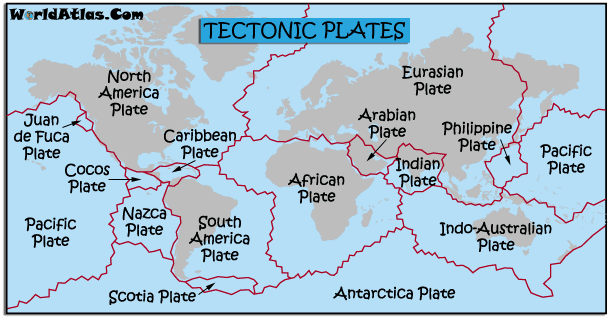In a world constantly changing, natural hazards are common and sometimes inevitable. There are numerous kinds of hazards. Namely, earthquakes, volcanic eruptions, tsunamis, hurricanes, typhoons, and drought. The chief focus of this essay is to distinguish between earthquakes and typhoons/hurricanes.
Spatial Extent:
Earthquakes and typhoons are very different in that they are two kinds of extremes. Earthquakes occur within the earth, whilst typhoons are occur in the sky. Earthquakes are caused by the movement of tectonic plates, therefore they happen mostly along tectonic plate boundaries.
 |
| Figure 1: map of tectonic plates |
Figure 1 above shows the tectonic plates. A recurring location for earthquakes is Japan, which lies directly on the boundary between the Eurasian Plate and the Philippine Plate.
Typhoons on the other hand, these occur in low pressure systems above tropical waters. Eastern and Southeast Asian countries, such as Philippines, India, and China experience numerous typhoons annually.
 |
| Figure 2: spatial distribution of hurricanes/typhoons |
Predictability
Earthquakes and Typhoons are distinct in that earthquakes are difficult to predict, because the only definite way of predicting a quake is moments before it strikes, through foreshocks. On the other hand, typhoons can be more easily tracked and predicted. This is because typhoons form a large mass of wind, rain, and clouds that can easily be seen by a satellite.
Frequency & Magnitude
Earthquakes happen frequently, but the magnitude differs. Generally speaking, the greater the magnitude, the less frequent the quake. A magnitude of less than 2 on the Richter scale happen several million times in one year, while a magnitude of 9 or greater will occur once in 10-50 years. For example, during the 2010 Christchurch earthquake, there were 12,911 quakes within 24 hours.
Typhoons as a whole do not occur as often as earthquakes, stronger typhoons are much more common than stronger earthquakes. Most typhoons typically occur in the months of June and July, and become less frequent in the months of January and February. The reason for the large occurrence in June/July is because of the warmer waters. Stats show that between 1959 and 2011, there was an average of 5.6 typhoons in the month of August.
 |
| Figure 3:Satellite image of typhoon Yolanda approaching the Philippines |
Speed of Onset
An earthquake typically lasts only a few seconds, however, the aftershocks can continue for months after the initial quake. For example, in Japan, the earthquake that happened in April of 2011, had aftershocks as far as December 2012. Typhoons, typically last longer than an earthquake. They can last from a few hours and a couple of days, depending on the speed and velocity.
Effects
Both earthquakes and typhoons can potentially cause a range of damages, from minimal damage to catastrophic.
This can be seen through earthquakes. There are thousands of quakes a day and very little are felt on the surface. Conversely, earthquakes have the potential to cause massive destruction. An example is the 9.0 magnitude earthquake in Japan. It caused a tsunami with 13,355 fatalities.
 |
| Figure 4: Damage caused by Christchurch earthquake |
Typhoons bring a lot of rain and wind to a particular area. Hurricane Frances in 2004 only caused 6 casualties, wherein Typhoon Yolanda in 2013, which was recorded as the strongest typhoon to ever hit landfall, caused 5,260 casualties. Asides from lives being taken, the livelihood of people can be destroyed. In areas such as the Philippines, during the strongest typhoons, farmers lose their crops and fishermen suffer from a decline in fish yields. The extent of these damages can be seen globally, and do not only occur in LEDC's.
 |
| Figure 5: Damage caused by typhoon Yolanda |
In conclusion, earthquakes and typhoons differ greatly in characteristics, predictability, and spatial distribution, however, they are similar in that they can cause catastrophic damages to the infrastructure of an area as well as destroying the livelihoods of numerous people, especially in LEDC's. Natural hazards are, as they are called, natural. These are often inevitable and the best way to approach these hazards is to be prepared.




